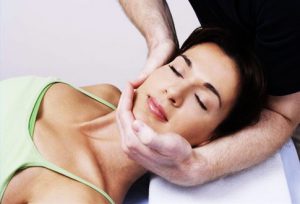by Troy Vander Molen, PT, DPT
 If you grew up in my day and age, you might associate “snap, crackle, pop” with the breakfast cereal Rice Krispies. Now, being the age that I am, I’m also beginning to associate that phrase with the sound I make when I move, cracking your neck!
If you grew up in my day and age, you might associate “snap, crackle, pop” with the breakfast cereal Rice Krispies. Now, being the age that I am, I’m also beginning to associate that phrase with the sound I make when I move, cracking your neck!
Since the dawn of creation, our bodies’ biggest enemies have been time and gravity. As a result of a generation of technological advancements, humans today are being impacted by time and gravity in new and different (and more substantial) ways. Think of the postures encouraged by hours at computer workstations and on our smartphones.
As a physical therapist, I’ve had many clients say that they feel like something needs to be cracked to loosen it up. Usually, my clients are referring to a pain and stiffness somewhere in their spine. The release that occurs with spinal manipulation can be perceived by certain individuals as bringing instant pain relief.
The medical term for the noise you hear when a joint pops is joint cavitation. Within each joint, there is fluid that acts as a cushion for the joint. When movement occurs at the joint, a vacuum is created, and the joint pops as fluid rushes back into the joint cavity. This phenomenon can occur either spontaneously by an individual or intentionally by a licensed medical professional like a physical therapist or chiropractor.
In my experience as a physical therapist, it is most common for people with a stiff neck to seek a quick answer to their problem, but is a “snap, crackle, pop” of the neck a safe and effective thing to do? Will it cause arthritis? Could it be potentially hazardous? Is cracking your neck all it’s cracked up to be?
First, let’s discuss the impact of joint popping on arthritis or joint damage. A 2011 study by deWeber et al published in the Journal of the American Board of Family Medicine found no correlation between knuckle cracking and osteoarthritis. That does not mean that there are no effects from cracking a joint. Dr. Pedro Beredjiklian, Chief of Hand and Wrist Surgery at the Rothman Institute in Philadelphia, PA, indicates that cracking a joint loosens “both its capsule and the surrounding ligaments. And the looser those components become, the more easily your joint will pop.” In other words, the more you crack your neck, the more you’ll feel the need to crack your neck.
 Sometimes you’ll hear horror stories of possible major concerns with spinal manipulation of the neck (i.e. cervical spine). For example, from time to time you’ll hear about a person experiencing a stroke after receiving joint manipulation of the upper neck. While a stroke is a very bad outcome, studies indicate one will occur in as little as one in 6 million upper cervical manipulations. So not only is it a highly unlikely occurrence as a side effect, but also in most cases, it’s entirely preventable when well-trained health care professionals do the appropriate testing before cervical manipulation.
Sometimes you’ll hear horror stories of possible major concerns with spinal manipulation of the neck (i.e. cervical spine). For example, from time to time you’ll hear about a person experiencing a stroke after receiving joint manipulation of the upper neck. While a stroke is a very bad outcome, studies indicate one will occur in as little as one in 6 million upper cervical manipulations. So not only is it a highly unlikely occurrence as a side effect, but also in most cases, it’s entirely preventable when well-trained health care professionals do the appropriate testing before cervical manipulation.
There are people who respond very favorably to cervical manipulation. Dr. Jeff Moore, DPT, a physical therapist and educator in manual therapy techniques, describes that there is a major relay station in the neck that consists of nerves that travel between the head and neck. If you experience one-sided headache pain with neck pain or stiffness, and your symptoms tend to get worse in an upright posture, you are likely to respond well to a manipulation of that region.
Why is that benefit experienced? A review article by JG Pickar in a 2013 edition of the Spine Journal explains the positive effects of spinal manipulation. Techniques that result in “cracking” of the neck create a stimulation can dampen the experience of pain through something known as the gate control theory.
Think of it this way. Imagine you stubbed your toe, a minor but definitely painful experience. Now imagine that you experience another more significant injury, like a broken arm. For a while, you may totally forget about your stubbed toe because the new and more substantial stimulus overrides the original less significant problem. In a similar way, the neurological response to spinal manipulation can momentarily override the pain signals and reduce the pain experience.
At Kinetic Edge Physical Therapy, we believe that spinal manipulation can be a beneficial treatment option for some people, because the current evidence supports its use in specific situations. In fact, the most recent research has shown that exercise and manual therapy together is better at reducing pain and enhancing function than exercise or manual therapy alone. In other words, if you crack your neck it can effectively treat a symptom immediately, but it doesn’t solve the root problem.
It is also important to note that spinal manipulation is just one of many types of manual treatment options. To get long-term benefit, the manual treatment doesn’t need to be a manipulation, and it must be combined with a more comprehensive assessment that helps you understand why this area of your spine feels tight.
The best benefits of manual therapy come when the treatment is specifically applied. Each joint has a particular design, so the degree and direction of movement matters. That’s why treatment from a trained professional is much more effective (and safe) than self-treatment.
 So, is it OK if you crack your neck? If done infrequently, it is probably harmless, but if you find yourself needing to do it more and more, seek professional help from a physical therapist trained in manual treatment techniques. It is likely a symptom caused by inefficient posture, which can accumulate into a more significant problem over time, and a thorough assessment will take into account all the factors that contribute to the pain.
So, is it OK if you crack your neck? If done infrequently, it is probably harmless, but if you find yourself needing to do it more and more, seek professional help from a physical therapist trained in manual treatment techniques. It is likely a symptom caused by inefficient posture, which can accumulate into a more significant problem over time, and a thorough assessment will take into account all the factors that contribute to the pain.
If it hurts to crack your neck, don’t do it! In most cases, no pain occurs when you produce a sound, which means that the tissue involved is most likely to be a soft tissue. However, noises accompanied by pain may indicate joint surface damage, and further assessment by a medical professional is warranted.
If you’ve experienced periodic neck pain and would like to “test drive” our well-trained physical therapists, just call 866-588-0230 to schedule a free screen. For no cost and with no obligation, you might just get the answer you need to solve the root problem once and for all, and you can say good-bye to your personal Rice Krispies!



